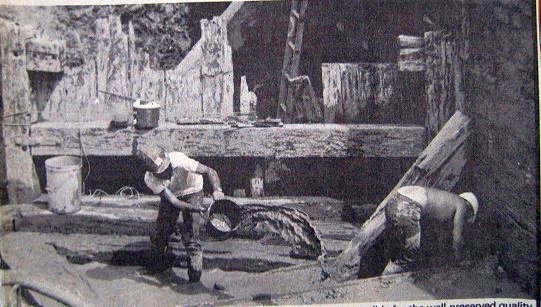UNLOCKING THE SECRETS OF THE CANAL
Excavation-history in the making
By Paul Bagnell
[Welland Tribune, 4 June 1987]
ST. CATHARINES-Lock 24 is again under tonnes of earth-perhaps for good this time-but many of its secrets have been pulled forever to the surface.
The new complete excavation of Lock 24 in St. Catharines, one of those that made up the original Welland Canal, has both confirmed previously held beliefs and shed new light on the construction of the first canal.
“It was history in the making,” says John Mathot of the Welland Canals Preservation Association of the canal’s construction. The excavation project of Lock 24 has brought into clearer focus exactly how that history was made.
“Several things surprised us,” said Mathot. “One was that it was 28 feet deep, not 15 feet, as the literature tells us. Also, some of the lower portions were built with stone blocks-it was supposed to have been built all of wood.”
Also found were sluice gates in the lock’s doors. The gate allowed water to flow through the doors, taking pressure off them as they moved open or closed. Other methods could have been used to accomplish the same effect, Mathot said, and canal experts until now have had no idea which was used on the original canal.
“That was a real bonus,” Mathot said.
During the dig, about 3,000 people appeared to view the old structure.
Lock 24 measures 110 feet long and 22 feet wide. It had a lift (the vertical distance a vessel would have travelled after exiting) of ten feet and a draft (the distance between a ship’s bottom and the floor of the lock) of eight feet. It had a floor of oak planks and “cribs” used to support the wooden walls. It was built with a “tongue and groove” construction, its massive oak beams being held in place with wooden pegs.
The lock is believed to be the only one remaining from the first Welland Canal, built in the 1820s. It is thought the roughly 40 other locks were dismantled so that their oak timbers could be sold off, a theory supported by old newspaper advertisements offering them for sale.
The project was carried out by a London, Ontario firm experienced in archeological digs. A team of four archeologists and five workers used a bulldozer, a front-end loader and finally hand tools to bring the lock into view.
The threat of liability arising from accidents prevented it from being left open, said Mathot, but the sluice gate and other artifacts found-tools, bottles and pieces of pottery-will be sent to museums and a replica of the lock is planned to be constructed.
The lock has been remarkably will preserved since being buried roughly 140 years ago. A high level of underground water and the fact it was buried in clay-rich soil kept air from its huge oak beams, preventing them from decaying.
The first canal was built by the Merritt-Welland Canal Company in the 1820s. Because they were a private company, they chose wood beams as the most economical way of building the waterway. The second and third canals were built with stone blocks.
 Subscribe..
Subscribe..

Add A Comment
You must be logged in to post a comment.